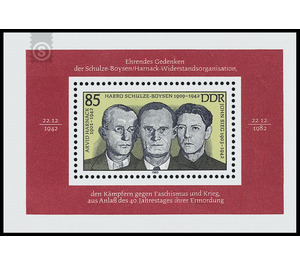Resistance organization Schulze-Boysen / Harnack - Germany / German Democratic Republic 1983
Theme: Calender
| Country | Germany / German Democratic Republic |
| Issue Date | 1983 |
| Item Type | Block |
| Chronological Issue Number | 3171 |
| Chronological Chapter | GER-DDR |
| SID | 844309 |
| In 22 Wishlists | |
To commemorate the Schulze-Boysen / Harnack resistance organization In memory of the Schulze-Boysen / Harnack resistance organization, the Ministry of Posts and Telecommunications of the German Democratic Republic issues a multi-colored special postage stamp block. No Special First Day Cover Special cancellation from March 22 to May 21, 1983 Honorary commemoration of the Schulze-Boysen / Harnack resistance organization, the fighters against fascism and war, the 40th anniversary of their murder On December 22, 1982, the 40th anniversary of the execution was celebrated by Harro Schulze-Boysen, Arvid Harnack and eight other comrades. To commemorate the 56 murdered fighters of this important resistance organization, this special postage stamp block with the portraits of Harro Schulze-Boysen, Arvid Harnack and John Sieg is published. The unification of various anti-fascist groups in 1938-39 by these outstanding combatants was a piece of practical popular front policy and an example of the realization of the decisions of the KPD at its conferences in Brussels (1935) and in Bern (1939). Schulze-Boysen, Harnack and Sieg represent the core of this organization alongside other communists. Social Democrats, trade unionists, believers and atheists, bourgeois democrats and non-party members fought alongside them; among them were officers and soldiers, scientists, doctors, teachers, artists, tradespeople and students. Harro Schulze-Boysen, b. on September 2, 1909 in Kiel, came from a middle-class family home, his father was Corvette captain. Harro was guided from his earliest youth by humanist ideals. He worked at the University of Berlin. Through his life dragged the political commitment. He gathered a steadily growing circle of Hitlerite opponents around him. From 1934 until his arrest he was an officer in the Reich Aviation Ministry. Concern over the fate of the German people led Harro to selflessly support the Soviet Union as a scout, beginning in 1941, to help end the war more quickly. In his farewell letter to his parents he wrote: "Everything I did, I did out of my head, my heart and my conviction. Arvid Harnack comes from a well-known German scholar family. He received his doctorate in 1924 to Dr. med. jur. and 1931 to the Dr. phil. The integrity of the scientist led him to translate this fact into reality in the systematic study of the classics of Marxism-Leninism as a true recognition in the battle front for the liberation of humankind from oppression and exploitation. Immediately after the establishment of the Hitler dictatorship in 1933, he rallied Hitler's opponents. Arvid became upper government councilor in the Ministry of Economic Affairs in the course of its further development. Imbued with deep friendship with the Soviet Union, which he considered the first peace state, and in view of the anti-Sovietism of the Hitler regime, he served as a scout for the Soviet Union from 1935 until his arrest. John Sieg was born on February 3, 1903 in Detroit USA. His father had emigrated to the USA as a German mechanic. John worked in the car companies Ford and Packard on the assembly line. Incidentally, he studied philosophy, philology and education at the evening university. In 1928 he returned to Germany and in 1929 became a member of the KPD. John Sieg proved to be a gifted journalist. At the end of 1929 he became a member of the editorial staff of the central organ of the KPD "Die Rote Fahne". On behalf of the illegal Berlin KPD organization, he worked closely with Harro Schulze-Boysen and Arvid Harnack for the end of the war and the establishment of a peaceful, democratic Germany together. On October 11, 1942, he was arrested. After cruel maltreatment in the Gestapo building on Prinz-Albrecht-Strasse in Berlin, John Sieg chose suicide.


